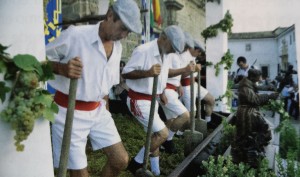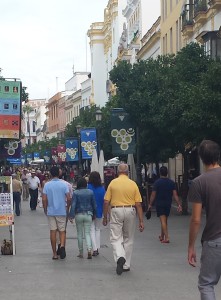It’s grape harvest time in Jerez, as it is across the Mediterranean. My first encounter with this traditional activity and the celebration which accompanies it was in Italy as a child. The red wine made around Lake Garda was, almost invariably, Bardolino and the Bardolini  celebrated in social, outdoor fashion ( spoiling this up-tight English child, probably irretrievably ). Since then I have followed the town band in Corbieres, from eglise to mairie, to taste both the red and the white of that year in the town square in the south of France. But neither of these occasions compares with the celebrations in Jerez. Perhaps it’s because Jerez is sherry, its ancient name, Xeres, giving us the very word. Maybe in Bordeaux or Beaune the celebrations are something similar, but somehow I doubt it.
celebrated in social, outdoor fashion ( spoiling this up-tight English child, probably irretrievably ). Since then I have followed the town band in Corbieres, from eglise to mairie, to taste both the red and the white of that year in the town square in the south of France. But neither of these occasions compares with the celebrations in Jerez. Perhaps it’s because Jerez is sherry, its ancient name, Xeres, giving us the very word. Maybe in Bordeaux or Beaune the celebrations are something similar, but somehow I doubt it.
The harvest is in early this year, the summer has been so hot that the grapes have ripened more quickly than usual. In Bardolino and Corbieres this might be a cause for concern, will it affect the quality of the resulting wine? Not in Jerez, where the solera system of production, a blending of wines of different vintages, ensures consistency of quality. You will never see a vintage year on a bottle of sherry, for this very reason.
As elsewhere across southern Europe the church plays a role in the celebration, in this case Jerez Cathedral, outside  which a group of grape harvesters, dressed in traditional costume ( an unfeasible white ) tread the grapes. The production of the mosto, the first pressings, is heralded by the Hymn of the Harvest, sung in the Cathedral and the wine is blessed. This setting is particularly appropriate in Jerez, for it was the taxes from the sale of sherry and brandy which funded the construction of the Cathedral.
which a group of grape harvesters, dressed in traditional costume ( an unfeasible white ) tread the grapes. The production of the mosto, the first pressings, is heralded by the Hymn of the Harvest, sung in the Cathedral and the wine is blessed. This setting is particularly appropriate in Jerez, for it was the taxes from the sale of sherry and brandy which funded the construction of the Cathedral.
This being Jerez the celebration is accompanied by much eating and drinking and, of course, music. La Fiesta Gastronomica takes place in the Alameda Vieja, just outside the Alcazar. This open square is lined with ‘casetas’, tented booths for wining and dining. The city’s restaurants each take a caseta and offer their wares as Jerezianos stroll, listening to the music from the bandstand on the Alameda or under the coloured lights, from caseta to caseta. At least that’s the theory, but, in fact, it’s incredibly difficult to get a table at any of them after nine  o’clock, as I can attest. The casetas open from one in the afternoon until two in the morning and are very reasonably priced.
o’clock, as I can attest. The casetas open from one in the afternoon until two in the morning and are very reasonably priced.
Traditional sherry and brandy is available and many of the sherry houses open their doors for the duration of the fiesta. There is sherry sampling in the evenings at the 13th century Cloisters of Santo Domingo, ( entrance free, sherries cost between 1 and 2 euros ) with tapas. There are also newer concoctions around. On Friday I dined at the restaurant of the inventor of the most recent – ‘Pepelimon’ -a mixture of fino sherry, lemon, mint and crushed ice which is now being marketed by Tio Pepe. I didn’t try it, but there were plenty of people who did.
Jerez and Cadiz are only just waking up to the fact that their region produces some excellent wines aside from sherry. Bodega Luis Perez produces the first-rate Garum, Vino Tierra de Cadiz, named after the Roman word for fish sauce  which was produced in industrial quantities near Cadiz in the time of Imperial Rome. There is also ‘CJ’ a good red wine purchased for very little from the monastery shop on Calle Medina ( just round the corner from me ) and Entrechuelos, both white and red, from Bodegas Miguel Domecq in Jerez, an old name re-launching a new product.
which was produced in industrial quantities near Cadiz in the time of Imperial Rome. There is also ‘CJ’ a good red wine purchased for very little from the monastery shop on Calle Medina ( just round the corner from me ) and Entrechuelos, both white and red, from Bodegas Miguel Domecq in Jerez, an old name re-launching a new product.
To accompany all of this activity there is a full programme of cultural events, some of which I enjoyed while I was there. I will be reporting on them in my next post.
If you enjoyed reading this piece you may also enjoy Festival de Jerez Festival de Jerez II Andalucian Spring II – La Feria


 RSS – Posts
RSS – Posts